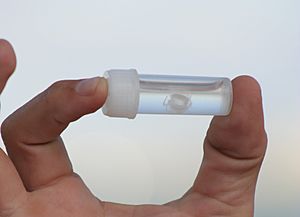Malo maxima facts for kids
Quick facts for kids Malo maxima |
|
|---|---|
| Scientific classification |
The Malo maxima is a very small but dangerous type of Irukandji jellyfish. It can cause a serious illness called Irukandji Syndrome. This jellyfish is one of four species in the Malo group, which also includes Malo bella, Malo filipina, and Malo kingi.
Scientist Lisa-ann Gershwin first described the Malo maxima in 2005. She also discovered Malo bella and Malo kingi, along with over 200 other jellyfish species! A strange thing about Malo maxima is that it swims more like a fish than a typical jellyfish, but scientists don't know why yet.
About Malo maxima
The Malo maxima jellyfish has a tall, narrow body with a flat top. It can grow to about 5 centimeters (about 2 inches) tall. Even though it's tiny, it's actually the biggest jellyfish in the Malo group. These jellyfish are also see-through, which makes them very hard to spot in the water.
Scientists have studied how Malo maxima grows. They found that it takes about 111 days for a Malo maxima to change from a tiny, attached polyp (a stage that stays in one place) into a free-swimming jellyfish.
Where it Lives
Irukandji jellyfish can be found in oceans all over the world. However, the Malo maxima specifically lives in the warm, tropical waters off western Australia. You can find them especially around the Broome area.
Scientists think that Malo maxima might prefer certain places to live, as they are often found in similar regions. But there isn't strong proof for this idea yet. This is because scientists haven't found their polyp stage, which is the part of their life cycle that stays put.
Irukandji jellyfish usually stay away from the shore. But sometimes, they might drift closer to beaches. This is often the only time people come across them, unless it's "bloom season." If you feel what seems like "sea lice" in the water, or see groups of salps (small, clear, barrel-shaped sea creatures), it could be a sign that Irukandji jellyfish are nearby.
Its Sting and What it Does
The sting from any Irukandji jellyfish can cause Irukandji Syndrome. This can be very dangerous and even deadly. The sting of the Malo maxima is considered the most dangerous among all the Malo species.
Only two types of jellyfish have venom strong enough to cause Irukandji Syndrome: Irukandji jellyfish and Box jellyfish. Box jellyfish are much more venomous than Irukandji jellyfish, and their stings are often more deadly. However, Irukandji stings are still very dangerous and painful.
Irukandji Syndrome can cause many symptoms. These include sweating, feeling very anxious, muscle spasms, and dangerously high blood pressure. Later, it can lead to low blood pressure and even heart problems. The sting itself might not look like much, and the symptoms don't appear right away. They usually get worse over time.
Scientists have recently learned how the venom of Malo maxima affects the heart. The venom mainly affects the left side of the heart, making it pump harder. It doesn't seem to affect the right side. The venom also makes certain nerves release a chemical called CGRP, but only in the left side of the heart and in the blood vessels that resist blood flow.
The best way to treat Irukandji Syndrome seems to be with an intravenous (IV) infusion of magnesium.
Jellyfish Blooms
Australia often experiences very large gatherings of jellyfish, called "blooms." These blooms include Malo maxima and other types of Irukandji jellyfish. Human activities, like fishing and pollution, might be making these blooms happen more often.
These large groups of jellyfish can harm the ocean's ecosystems. They can also make it hard for ships to travel and make the water very dangerous for divers.
- Straehler-Pohl, I., Carrette, T., Sleeman, J., Seymour, J., Underwood, A., Carrette, T., & Seymour, J. (2018). Early life history and metamorphosis in Malo maxima Gershwin, 2005 (Carukiidae, Cubozoa, Cnidaria). Plankton and Benthos Research, 13(4), 143–153.


